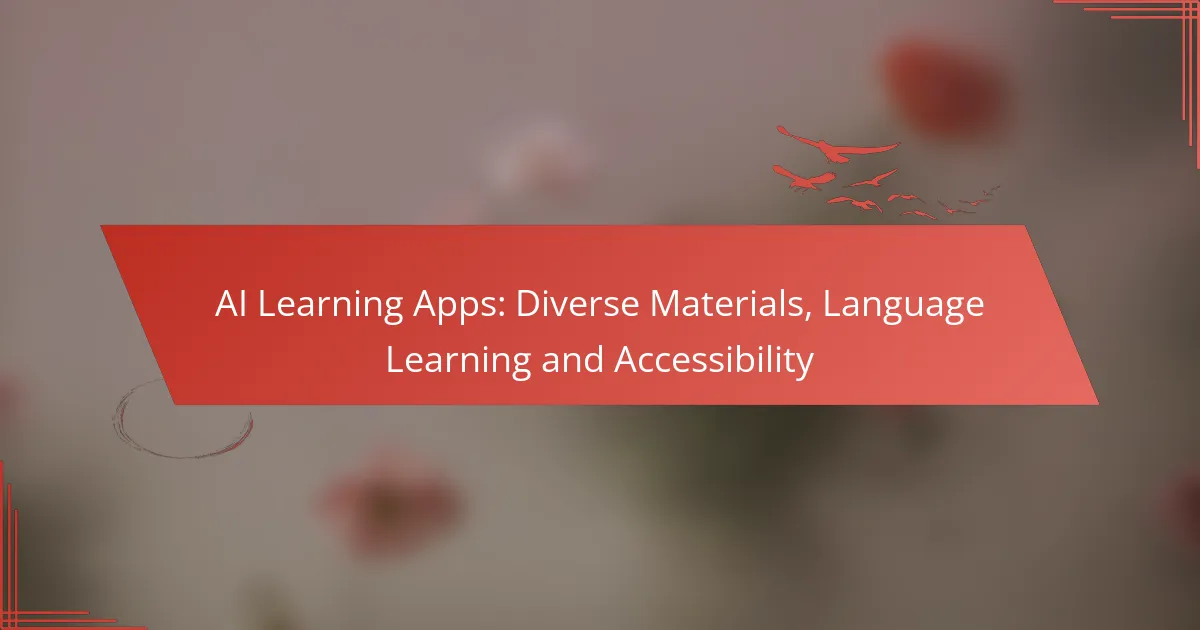AI learning apps are revolutionizing language acquisition by offering personalized experiences that cater to individual learning styles. With a diverse array of materials such as interactive exercises and video lessons, these applications enhance user engagement and make learning more enjoyable. Additionally, they promote accessibility by tailoring educational content to meet the needs of learners with varying abilities, ensuring that everyone can benefit from effective language education.

What Are the Best AI Learning Apps for Language Learning?
The best AI learning apps for language learning are designed to enhance user engagement and provide personalized experiences. These apps utilize advanced algorithms to adapt to individual learning styles, making language acquisition more effective and enjoyable.
Duolingo
Duolingo is a popular language learning app that gamifies the learning process, making it fun and interactive. Users can choose from a wide range of languages and engage in bite-sized lessons that include vocabulary, grammar, and pronunciation exercises.
One of Duolingo’s key features is its adaptive learning technology, which adjusts the difficulty of tasks based on user performance. This ensures that learners are consistently challenged without feeling overwhelmed.
Babbel
Babbel focuses on practical language skills, offering courses tailored to real-life conversations. The app emphasizes speaking and listening, making it suitable for users who want to communicate effectively in their target language.
Each lesson is designed by language experts and covers various topics, from travel to business. Babbel also provides speech recognition technology to help improve pronunciation, enhancing the overall learning experience.
Rosetta Stone
Rosetta Stone is known for its immersive approach to language learning, using a method that emphasizes context and visual cues. This app is particularly effective for users who prefer a more intuitive learning style without relying heavily on translations.
Rosetta Stone offers live tutoring sessions and speech recognition features, allowing learners to practice speaking with native speakers. This combination of tools helps users develop confidence in their language skills.
Busuu
Busuu combines language learning with social interaction, allowing users to connect with native speakers for practice. The app offers a structured curriculum that includes grammar, vocabulary, and writing exercises.
One unique aspect of Busuu is its community feedback feature, where learners can submit written exercises and receive corrections from native speakers. This peer interaction can significantly enhance the learning process.
Memrise
Memrise utilizes spaced repetition and mnemonic techniques to help users retain vocabulary and phrases effectively. The app is designed to make learning enjoyable through engaging videos and interactive quizzes.
Memrise offers a variety of courses created by both the app’s team and its user community, ensuring a diverse range of content. This flexibility allows learners to focus on specific areas of interest or need, making it a versatile tool for language acquisition.

How Do AI Learning Apps Enhance Accessibility?
AI learning apps enhance accessibility by providing tailored educational experiences that cater to diverse needs. These applications leverage technology to support learners with varying abilities, ensuring that everyone can engage with educational content effectively.
Text-to-Speech Features
Text-to-speech (TTS) features convert written text into spoken words, making content more accessible for individuals with visual impairments or reading difficulties. This functionality allows users to listen to lessons, instructions, or reading materials, which can significantly improve comprehension and retention.
Many AI learning apps offer customizable voice options and adjustable reading speeds, enabling users to select settings that best suit their preferences. This personalization enhances the learning experience, making it more engaging and effective.
Customizable Learning Paths
Customizable learning paths allow users to tailor their educational journey based on their unique strengths and weaknesses. AI algorithms analyze user performance and preferences, creating a personalized curriculum that adapts over time.
For example, a language learning app might adjust vocabulary lessons based on the user’s progress, focusing on areas where they struggle while skipping topics they have mastered. This flexibility ensures that learners remain motivated and challenged appropriately.
Support for Diverse Learning Styles
AI learning apps support diverse learning styles by offering various content formats, such as videos, quizzes, and interactive exercises. This variety caters to visual, auditory, and kinesthetic learners, ensuring that everyone can engage with the material in a way that resonates with them.
Additionally, many apps incorporate gamification elements, which can enhance motivation and retention for learners who thrive on competition and rewards. By recognizing and accommodating different learning preferences, these applications create a more inclusive educational environment.

What Types of Materials Do AI Learning Apps Offer?
AI learning apps provide a variety of materials designed to enhance language acquisition. These include interactive exercises, video lessons, and quizzes, each tailored to different learning styles and objectives.
Interactive Exercises
Interactive exercises engage users through hands-on activities that reinforce language skills. These can include fill-in-the-blank tasks, matching games, and conversation simulations that adapt to the learner’s progress.
Many apps utilize gamification techniques to make learning enjoyable and motivating. For instance, users might earn points or badges for completing exercises, which encourages consistent practice.
Video Lessons
Video lessons offer visual and auditory learning experiences, making complex concepts easier to understand. These lessons often feature native speakers, providing learners with authentic pronunciation and cultural context.
Typically ranging from a few minutes to half an hour, video lessons can be paused and replayed, allowing learners to absorb information at their own pace. Look for apps that provide subtitles to enhance comprehension.
Quizzes and Assessments
Quizzes and assessments are essential for tracking progress and reinforcing knowledge. They can range from simple multiple-choice questions to more complex scenarios that require critical thinking and application of language skills.
Regular assessments help identify strengths and weaknesses, allowing learners to focus on areas needing improvement. Consider apps that offer immediate feedback, as this can significantly enhance the learning experience.

How Do Subscription Models Work for AI Learning Apps?
Subscription models for AI learning apps typically involve users paying a recurring fee for access to educational content and features. These models can vary in structure, offering different pricing tiers, payment frequencies, and benefits that cater to diverse learning needs.
Monthly vs Annual Plans
Monthly plans allow users to pay a smaller fee each month, providing flexibility to cancel or change subscriptions easily. However, annual plans often offer significant savings, sometimes reducing the total cost by 10-30% compared to monthly payments.
When choosing between these options, consider your commitment level and budget. If you plan to use the app long-term, an annual plan may be more economical.
Free Trials and Discounts
Many AI learning apps offer free trials, allowing users to test features and content before committing financially. These trials typically last from a week to a month, giving ample time to evaluate the app’s effectiveness.
Additionally, discounts may be available for first-time users or during promotional periods. Look for seasonal sales or referral bonuses that can further reduce costs.
Family and Group Memberships
Family and group memberships provide a cost-effective way for multiple users to access an AI learning app under a single subscription. These plans often allow several accounts for a lower combined price than individual subscriptions.
When considering a family plan, check the number of users allowed and whether each member can have personalized learning paths. This can enhance the learning experience for everyone involved.

What Are the Key Features to Look for in AI Learning Apps?
Key features to consider in AI learning apps include user interface design, content variety, and progress tracking tools. These elements significantly impact the effectiveness and enjoyment of the learning experience.
User Interface and Experience
A user-friendly interface is crucial for engagement in AI learning apps. Look for apps that offer intuitive navigation, clear instructions, and visually appealing layouts to enhance usability.
Consider features like customizable themes and accessibility options, which can cater to different learning preferences and needs. A well-designed app should minimize distractions and focus on the learning material.
Content Variety and Quality
High-quality content is essential for effective learning. Choose apps that provide a diverse range of materials, including videos, quizzes, and interactive exercises, to cater to various learning styles.
Additionally, ensure that the content is regularly updated and relevant to current language use. Apps that incorporate real-world scenarios and cultural insights can enhance the learning experience significantly.
Progress Tracking Tools
Effective progress tracking tools help learners monitor their advancement and stay motivated. Look for apps that offer features such as performance analytics, milestone achievements, and personalized feedback.
These tools can provide insights into strengths and weaknesses, allowing users to focus on areas needing improvement. Regularly reviewing progress can also encourage consistent practice and goal setting.

How Do AI Learning Apps Compare to Traditional Learning Methods?
AI learning apps offer personalized and adaptive learning experiences that can significantly differ from traditional methods. They leverage technology to tailor content to individual needs, making learning more engaging and efficient.
Personalization and Adaptability
AI learning apps use algorithms to analyze user performance and preferences, allowing them to customize lessons and materials. This adaptability can lead to a more effective learning process, as users receive content that matches their skill level and learning pace.
For example, if a learner struggles with vocabulary in a language app, the AI may provide additional exercises focused on that area. Traditional methods often follow a one-size-fits-all approach, which may not address individual challenges as effectively.
Access to Diverse Materials
AI learning apps typically offer a wide range of resources, including videos, quizzes, and interactive exercises. This variety can enhance engagement and cater to different learning styles, such as visual or auditory preferences.
In contrast, traditional learning methods may rely heavily on textbooks and lectures, which can limit exposure to diverse content. With AI apps, learners can explore topics in-depth and from multiple perspectives, enriching their understanding.
Cost and Accessibility
Many AI learning apps are available at a lower cost compared to traditional educational settings, making them more accessible to a broader audience. Some apps offer free versions or subscriptions that are significantly cheaper than tuition fees for in-person classes.
Moreover, AI learning apps can be accessed from anywhere with an internet connection, allowing learners to study at their convenience. This flexibility is particularly beneficial for those balancing work or family commitments, unlike traditional methods that often require fixed schedules.



